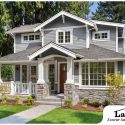You have a wide range of options when it comes to the colors and finishes of your home’s siding. Material and color are often the first factors. From vinyl to fiber cement, there is a siding material that’s sure to match your need for home protection, longevity and looks that match your budget. However, it’s also important to choose a profile that complements the rest of your exterior.

Here’s a quick guide to some of today’s most popular siding profiles grouped under horizontal, vertical and shake from a trusted gutter protection services provider.
1. Horizontal Siding Patterns
Horizontal patterns are the most common method of siding. They are proven to be effective against precipitation or invasive water particles from the atmosphere. This traditional siding method encompasses a variety of patterns:
- Traditional Lap – The siding boards are partially layered on top of the next board in a traditional lap setup. It’s great for areas where strong rains are common as they offer maximum protection. Traditional lap is usually the most affordable option.
- Dutch Lap – This may look like a traditional lap, but Dutch lap siding has a groove at the top of each board. The shadow in the groove gives the appearance of added texture. It’s just as effective as a traditional lap.
- Beaded – If you want something with more texture, beaded boards have a “bead” at the bottom that provides that look.
- Clapboard – This profile resembles a thin wedge. It is usually installed with one course slightly overlapping the one installed underneath it.
- Dolly Varden – This is also called rabbeted bevel. It resembles clapboard siding, except it has a completely flat face that goes against the sheathing.
2. Shake Siding Patterns
Unlike gutter covers, shake patterns are installed mostly for the accent. They used to be all wood shakes. The most preferred designs are square, round (semicircular lower edge), staggered (maximum texture), half cove (quarter-circular cut out on bottom two edges), fish scale, mitered corner and octagonal and hexagonal.
3. Vertical Siding Patterns
Although less common, vertical patterns are ideal for specific home styles.
- Panel – Placed on top of each other, with flush surfaces, panel siding is the vertical equivalent of the traditional lap.
- Board and Batten – To provide waterproofing, the boards have battens to cover the cracks. The profile is attractive, thanks to the shadow cast by the raised battens.
Our roofing and gutter professionals at Lask Exterior Solutions, LLC would love to introduce you to gutter guards. Call us at (815) 964-2220 or fill out our contact form to request a free estimate. We serve homeowners in Rockford, IL, and the surrounding communities.
